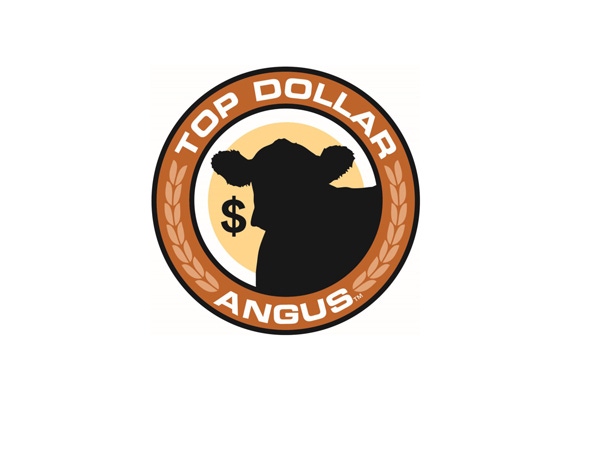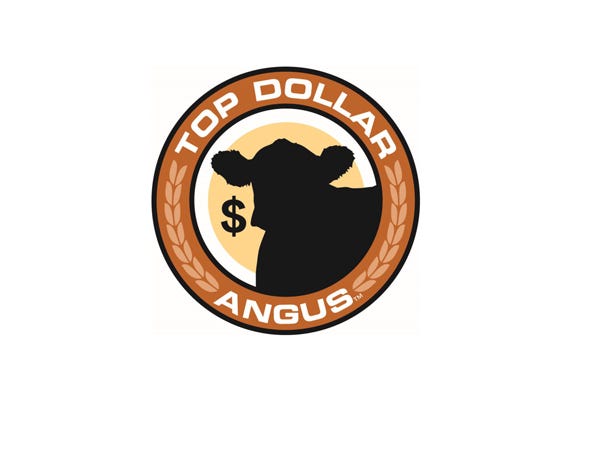Top Dollar Angus certifies feeder cattle gain and carcass merit.
December 3, 2014

Producers who retain ownership through the feedlot have been able to see the economic benefit of value-creating genetics for a while. Now, users of Angus genetics may be able to see it as easily via Top Dollar Angus (TDA), a genetic certification and marketing company Tom Brink launched in August.
As of late October, Brink has commitments from more than 35 feedlot partners to purchase more than 1 million head through the program each year. Qualifying cattle are eligible for at least a $50/head premium above the average market price.
To qualify for TDA, feeder cattle and calves must contain two or more generations of Angus genetics with growth and carcass traits in the top 25% of the breed.
Brink notes that gain and grade are the two most significant contributors to cattle value once they leave the ranch.
TDA qualification is verified through pedigrees and/or GeneMax testing, a DNA-based tool developed by Zoetis, Certified Angus Beef (CAB) and Angus Genetics Inc., which estimates the feedlot gain and marbling potential of individual cattle that are a high percentage Angus. Qualifying cattle receive an electronic identification (EID) tag. They become part of the TDA Process Verification Program coordinated through IMI Global Inc.
“To some degree, this is a CAB program for feeder cattle,” Brink says. As with CAB, he explains, TDA relies on identifying cattle that meet a set of desired specifications, labeling those that qualify, and marketing them based on the promise implied by the brand name applied to the cattle.

Photo Gallery: Home Is Where You Hang Your Hat
At BEEF, we're proud to celebrate the ranching lifestyle. Enjoy 70+ photos from our readers that showcase their country home. Enjoy the gallery now.
“It works by certifying calf crops that meet program requirements at the farm and ranch level, enabling these cattle to be marketed using the TDA brand name and logo,” Brink explains.
Certification — determining if cattle qualify — costs $2.50-$4/head depending on volume. If they do qualify, this certification fee also covers the requisite EID tag. The brand license fee is an additional $4/head.
“If the cattle don’t qualify, we’ll still help you market the calves,” Brink says. For cattle that don’t qualify, he emphasizes, “many will only be one generation away from getting there. No cattle are more than two generations away.”

Documenting added value
To explain why feedlots would be willing to pay an additional $50/head for calves in what is already a hefty calf market, it helps to understand some economics and history.
For economics, Brink shares data from a pen of 48 high-percentage Angus steers that serve as proof-of-concept cattle for TDA.
The steers were born in Missouri in spring 2013, and went on feed in Kansas, averaging 736 lbs. After 178 days on feed, the cattle averaged 1,406 lbs., with a 3.61-lb. average daily gain, and a feed conversion of 6.06 lbs. of feed to 1 lb. of gain. The cattle were DNA-tested with GeneMax Focus test and had an average score of 91.7 (1-99 scale).
The pen-average cost of gain was $86.50/cwt., and the steers ended up 92.2% Choice and higher, including 4.5% Prime and 44.4% CAB. There were 78% Yield Grade 1-3 carcasses. Even though the Choice-Select spread at the time was a narrow $5.22/cwt., the steers brought $84.63/head over the live market price.
“Had these steers been marketed when the Choice-Select Spread was $8/cwt. or more, they would have easily surpassed $100/head in grid premium,” Brink explains.
In other words, feedlots are willing to pay more when objective indicators suggest the cattle will return them more than the extra cost.
Ultimately, Brink understands the market will determine the TDA premium. So far, though, many of the calves marketed through TDA have commanded more than an extra $50. These are direct-trade cattle.
“If producers choose to market their TDA-certified calves at auction, we’ll do all we can to alert our partner feedlots to their availability, but we can’t guarantee a set premium,” Brink explains.
As for the history side of the equation, there are two points.
The first comes with understanding how little cattle feeders know about most of the cattle they buy.
The next comes by understanding the evolution of fed-cattle marketing.
“Ten to 15 years ago, the cattle feeding sector didn’t have as much experience managing cattle for grids and marketing them on grids. These days, with 60%-70% of fed cattle traded on grids, we now have lots of expertise in those areas,” Brink explains. “Everyone understands that cattle in the top end of the Angus breed are delivering superior feedlot and carcass value. Cattle with these credentials are worth more.”
If you favor breeds besides Angus, don’t feel like you’re being ignored. Brink says he’s starting TDA with an Angus focus because of the sheer numbers, and the depth and breadth of the breed’s genetic database. Such clout and data place Angus at the forefront of using genomic data and developing genomic tools.
“For producers who want to go this direction, this gives them a target,” Brink says. “It’s a path that will take you to higher-value cattle.”
You might also like:
5 Tips For Getting The Most Cash For Your Cull Cows
Why Cattle Should Not Ingest Net Wrap
Photo Gallery: Meet The Generations On The Ranch
Why You Must Act Now To Minimize Cold Stress On Cattle This Winter
3 Steps To Negotiating A Great Cow Lease
Anne Burkholder, The Feedyard Foodie, Is BEEF Magazines 2014 Trailblazer
How To Prevent & Treat Pinkeye In Cattle
About the Author(s)
You May Also Like





